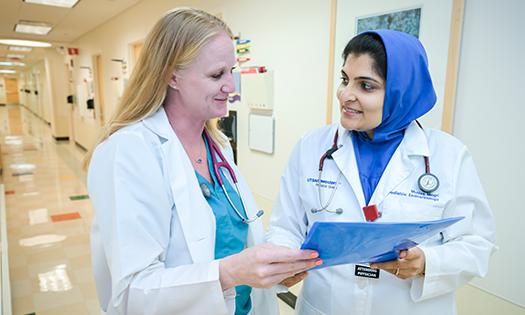The Innovation: Correcting the Underlying Problem Behind Patellar Instability
Children’s Health℠ Andrews Institute for Orthopaedics & Sports Medicine is the first center in Texas offering trochleoplasty, an innovative procedure that corrects the most common problem that leads to patellar instability: trochlear dysplasia. The trochlea is a “V” shaped groove at the end of the femur that holds the kneecap (patella) in place. When that groove isn’t as deep as it should be, the patella can slide out of place.
A trochleoplasty reshapes the dysplastic trochlea to create a new groove in the trochlea. This allows the kneecap to move normally, prevents dislocations and enables patients to get back to sports and other activities. At Children’s Health Andrews Institute, the procedure is performed by Lee Pace, M.D., who has completed more trochleoplasties than any other physician in the U.S. and is on a mission to bring its benefits to more patients nationwide.
The Big Picture: Clinical Studies Show Trochleoplasty Prevents Dislocations
Other procedures that work to compensate for dysplasia have been the historic American standard. Dr. Pace was trained in this manner and performed these procedures early in his practice. However, he noticed that a certain subset of his patients still suffered ongoing pain and dislocations.
These patients uniformly had high-grade trochlear dysplasia. Almost by accident, Dr. Pace attended a presentation by Philip Schöettle, M.D., Ph.D., who explained how and why trochleoplasty is an effective and appropriate treatment for high-grade trochlear dysplasia. Dr. Pace was so intrigued that he flew to Germany in 2016, and spent a week of hands-on training with Dr. Schöettle to learn the procedure.
“European physicians like Dr. Schöettle have led the charge with trochleoplasty, and have published long-term clinical results showing that the repair is durable and very effective,” Dr. Pace says.
Several European publications chronicle long-term clinical data showing that dislocations following trochleoplasty are very rare and that patients report a high rate of satisfaction. Many patients are able to be more active after the procedure than they have ever been.
“When I saw those results, my treatment algorithm changed on a dime,” Dr. Pace says.
Key Details: Helping Patients Resume Sports and Activities
Eligibility: Patients are eligible for trochleoplasty if they have a history of recurrent patellar instability, and if there is evidence that high-grade dysplasia is a principal factor.
Duration: Trochleoplasty is an outpatient procedure that takes about two hours and is conducted under general anesthesia, supplemented with a regional nerve block.
Ligament repair: As a routine part of the procedure, Dr. Pace will conduct ligament repair and re-tensioning during the trochleoplasty. This addresses the inherent ligament issues that occur as a result of patellar dislocations.
Healing: After the procedure, patients are encouraged to put weight on their knee as soon as possible, and to move and bend their knee to reduce pain and stiffness. “Weightbearing and early motion can actually help the trochleoplasty heal,” Dr. Pace says.
Recovery: Patients will not require a knee brace and there are no weight-bearing restrictions, but many patients choose to use crutches for 2-4 weeks to minimize discomfort. Most patients don't need pain medication for more than seven days.
Rehabilitation: Follow-up rehabilitation includes a series of progressive exercises designed to increase range of motion, stability and strength. At the Children’s Health Andrews Institute, this rehabilitation takes place in our state-of-the-art facility, which offers everything from an underwater treadmill to the EXOS sports performance system.
Resuming sports: Patients can typically resume sports and other intense physical activities within 4-6 months. Dr. Pace has used trochleoplasty to help many varsity and high-level athletes get back on the field safely. Those who follow their rehabilitation regimen are often stronger than they were before the procedure.
Why Children’s Health: Multidisciplinary Care from Pediatric Experts
Patients from across the nation, children and adults alike, have traveled to Dr. Pace to have him perform their trochleoplasty. He is fellowship-trained in both pediatric orthopedics and in pediatric and adult sports medicine. He’s also certified by the American Board of Orthopedic Surgery and earned a certificate in orthopedic sports medicine by that board.
After their trochleoplasty, Dr. Pace’s North Texas patients can benefit from the Children’s Health Andrews Institute’s integrated, collaborative care. Our surgical care is provided in the same facility as physical therapy and sports rehabilitation, and Dr. Pace works hand-in-hand with the Children’s Health Andrews Institute’s physical therapy and rehabilitation experts who have dedicated their careers to helping children and teens recover from injuries and live full, active lives.
“I can communicate directly with all of our rehab specialists about each patient, and they can let me know if and when they have any questions,” Dr. Pace says. “That enables us to provide personalized care for every patient and to keep them on track toward the best possible outcome.”
Our collaborative approach is one reason why Dr. Pace joined the Children’s Health Andrews Institute in 2021 and why he’s excited for the institute to be his home base as he works to expand the use of trochleoplasty.
“When I learned about how effective trochleoplasty can be, I resolved to champion it here in U.S.,” Dr. Pace says. “It’s my most important professional goal because I’ve seen what a difference it makes.”



